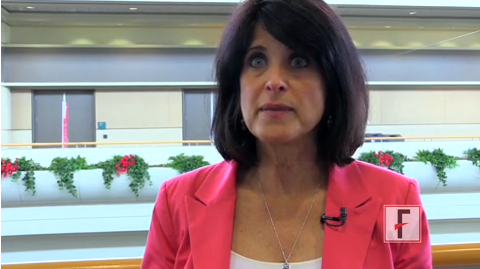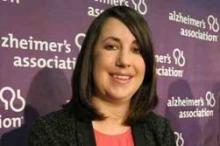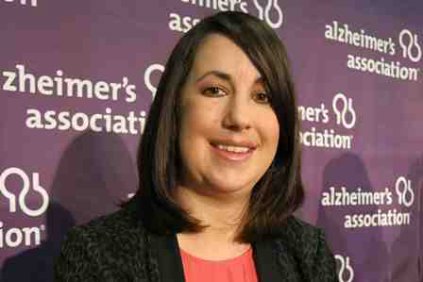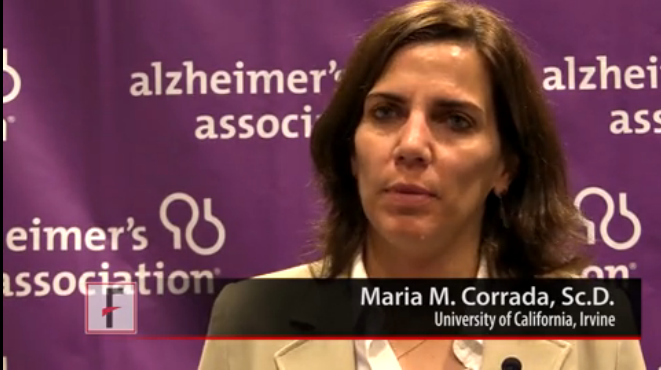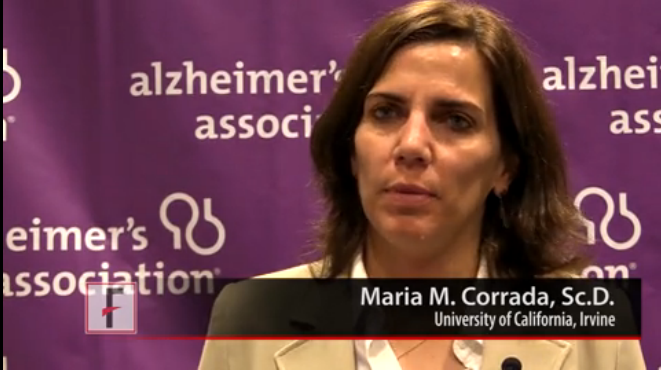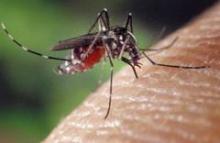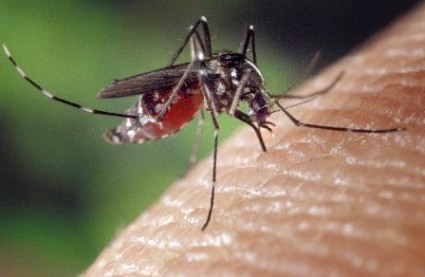User login
VIDEO: Tips from AADE’s Diabetes Educator of the Year
ORLANDO – Susan Weiner has been on the diabetes education front line for nearly 25 years, and she was just elected as Educator of the Year for her "special contributions to the field through dedication, innovation, and sensitivity in patient care" at the annual meeting of the American Association of Diabetes Educators.
Ms. Weiner, who is in private practice in Long Island, New York, also recently wrote a book, "The Complete Diabetes Organizer," to help patients organize various aspects of their lives so that they can successfully manage their diabetes.
In a video interview, Ms. Weiner shares some of her advice with physicians.
On Twitter @naseemmiller
The video associated with this article is no longer available on this site. Please view all of our videos on the MDedge YouTube channel
ORLANDO – Susan Weiner has been on the diabetes education front line for nearly 25 years, and she was just elected as Educator of the Year for her "special contributions to the field through dedication, innovation, and sensitivity in patient care" at the annual meeting of the American Association of Diabetes Educators.
Ms. Weiner, who is in private practice in Long Island, New York, also recently wrote a book, "The Complete Diabetes Organizer," to help patients organize various aspects of their lives so that they can successfully manage their diabetes.
In a video interview, Ms. Weiner shares some of her advice with physicians.
On Twitter @naseemmiller
The video associated with this article is no longer available on this site. Please view all of our videos on the MDedge YouTube channel
ORLANDO – Susan Weiner has been on the diabetes education front line for nearly 25 years, and she was just elected as Educator of the Year for her "special contributions to the field through dedication, innovation, and sensitivity in patient care" at the annual meeting of the American Association of Diabetes Educators.
Ms. Weiner, who is in private practice in Long Island, New York, also recently wrote a book, "The Complete Diabetes Organizer," to help patients organize various aspects of their lives so that they can successfully manage their diabetes.
In a video interview, Ms. Weiner shares some of her advice with physicians.
On Twitter @naseemmiller
The video associated with this article is no longer available on this site. Please view all of our videos on the MDedge YouTube channel
AT AADE 2014
Mindfulness meditation helped veterans with diabetes management
ORLANDO – They weren’t asked to sit in the lotus pose or study with the monks. Rather, a small group of older veterans were introduced to simple mindfulness meditation, and in a short period, they began doing a better job of managing the stress related to their diabetes and lowered their hemoglobin A1c levels.
More importantly, most said they enjoyed meditating, according to Monica DiNardo, Ph.D.
By the end of the 3-month feasibility study, conducted at the Veterans Affairs Pittsburgh Healthcare System, the participants’ diabetes-related stress had dropped by 41% and their HbA1c had dropped by roughly 1%.
The study was small – 28 patients – and it was not controlled, "so we really can’t draw generalizations from this," said Dr. DiNardo, who presented the study at the annual meeting of the American Association of Diabetes Educators. What it does show, she said, is that introducing the program wasn’t a distraction to the diabetes education process.
Helping patients manage diabetes-related stress is important, especially in the veteran population, where a quarter, or nearly a 1 million individuals, have diabetes.
And while healthy coping is one of seven self-care behaviors recommended by the AADE7 framework, many persons with diabetes don’t receive training for healthy coping strategies to deal with the stress that usually comes along with having diabetes.
"There’s a need to incorporate practical, evidence-based programs into diabetes self-management education (DSME) to fill this gap," said Dr. DiNardo, a diabetes nurse practitioner and an educator at the VA Pittsburgh.
To assess the feasibility of implementing a brief mindfulness intervention within diabetes self-management education, Dr. DiNardo and her colleagues created an intervention called Mind-STRIDE (Mindfulness Stress Reduction in Diabetes Education).
The research team used several assessment tools, including the Five Facet Mindfulness Questionnaire, Perceived Stress Scale, and Problem Areas in Diabetes Scale (to measure diabetes-related stress) to measure the changes over time.
The 28 veterans, who were on average 60 years old, were enrolled in DSME. The majority had type 2 diabetes and their HbA1c levels were higher than 7%. Also, half of the group was college educated, nearly 70% were married, and 60% were retired or disabled.
The group received a 90-minute training in mindfulness following their DSME session. Participants were given a CD, recorded by Dr. DiNardo, to practice with at home. They were also given practice diaries. They received a 30-minute booster session 1 month later.
Twenty of the 28 individuals stayed in the study; 11 completed their practice diaries. All said they found the intervention interesting and easy to understand, and almost all said that they learned something new and planned to continue practicing mindfulness.
Results after 3 months showed that there was a significant negative correlation between awareness and nonjudgment – two elements of the five-facet mindfulness – and diabetes-related stress. In contrast, the two facets showed a significant positive correlation with coping abilities. There were also significant positive correlations between the two facets and diabetes self management and the total AADE7 score.
Dr. DiNardo speculated that the meditation helped participants remove the self-judgment attached to having the disease and gain the ability to be aware of the disease and how to cope with it.
When assessing baseline to 3-month gain and effect size for various assessments, all showed changes in a "hopeful" direction, said Dr. DiNardo.
The most significant trend over the 3-month period was the 40% drop in diabetes-related stress (difference in raw scores), measured by the Problem Areas in Diabetes Scale. Meanwhile, awareness and coping ability increased slightly during the study period.
Dr. DiNardo said that the cost associated with implementing the program was minimal, and the only requirement was access to someone who knew mindfulness meditation.
"We need innovative therapy to promote healthy behaviors for patients with diabetes," she said. Mind-body therapies have the potential to serve as a bridge between the clinic and home and give patients yet another tool to manage their diabetes.
Dr. DiNardo had no financial disclosures. The study was supported by a grant from AADE.
On Twitter @naseemmiller
ORLANDO – They weren’t asked to sit in the lotus pose or study with the monks. Rather, a small group of older veterans were introduced to simple mindfulness meditation, and in a short period, they began doing a better job of managing the stress related to their diabetes and lowered their hemoglobin A1c levels.
More importantly, most said they enjoyed meditating, according to Monica DiNardo, Ph.D.
By the end of the 3-month feasibility study, conducted at the Veterans Affairs Pittsburgh Healthcare System, the participants’ diabetes-related stress had dropped by 41% and their HbA1c had dropped by roughly 1%.
The study was small – 28 patients – and it was not controlled, "so we really can’t draw generalizations from this," said Dr. DiNardo, who presented the study at the annual meeting of the American Association of Diabetes Educators. What it does show, she said, is that introducing the program wasn’t a distraction to the diabetes education process.
Helping patients manage diabetes-related stress is important, especially in the veteran population, where a quarter, or nearly a 1 million individuals, have diabetes.
And while healthy coping is one of seven self-care behaviors recommended by the AADE7 framework, many persons with diabetes don’t receive training for healthy coping strategies to deal with the stress that usually comes along with having diabetes.
"There’s a need to incorporate practical, evidence-based programs into diabetes self-management education (DSME) to fill this gap," said Dr. DiNardo, a diabetes nurse practitioner and an educator at the VA Pittsburgh.
To assess the feasibility of implementing a brief mindfulness intervention within diabetes self-management education, Dr. DiNardo and her colleagues created an intervention called Mind-STRIDE (Mindfulness Stress Reduction in Diabetes Education).
The research team used several assessment tools, including the Five Facet Mindfulness Questionnaire, Perceived Stress Scale, and Problem Areas in Diabetes Scale (to measure diabetes-related stress) to measure the changes over time.
The 28 veterans, who were on average 60 years old, were enrolled in DSME. The majority had type 2 diabetes and their HbA1c levels were higher than 7%. Also, half of the group was college educated, nearly 70% were married, and 60% were retired or disabled.
The group received a 90-minute training in mindfulness following their DSME session. Participants were given a CD, recorded by Dr. DiNardo, to practice with at home. They were also given practice diaries. They received a 30-minute booster session 1 month later.
Twenty of the 28 individuals stayed in the study; 11 completed their practice diaries. All said they found the intervention interesting and easy to understand, and almost all said that they learned something new and planned to continue practicing mindfulness.
Results after 3 months showed that there was a significant negative correlation between awareness and nonjudgment – two elements of the five-facet mindfulness – and diabetes-related stress. In contrast, the two facets showed a significant positive correlation with coping abilities. There were also significant positive correlations between the two facets and diabetes self management and the total AADE7 score.
Dr. DiNardo speculated that the meditation helped participants remove the self-judgment attached to having the disease and gain the ability to be aware of the disease and how to cope with it.
When assessing baseline to 3-month gain and effect size for various assessments, all showed changes in a "hopeful" direction, said Dr. DiNardo.
The most significant trend over the 3-month period was the 40% drop in diabetes-related stress (difference in raw scores), measured by the Problem Areas in Diabetes Scale. Meanwhile, awareness and coping ability increased slightly during the study period.
Dr. DiNardo said that the cost associated with implementing the program was minimal, and the only requirement was access to someone who knew mindfulness meditation.
"We need innovative therapy to promote healthy behaviors for patients with diabetes," she said. Mind-body therapies have the potential to serve as a bridge between the clinic and home and give patients yet another tool to manage their diabetes.
Dr. DiNardo had no financial disclosures. The study was supported by a grant from AADE.
On Twitter @naseemmiller
ORLANDO – They weren’t asked to sit in the lotus pose or study with the monks. Rather, a small group of older veterans were introduced to simple mindfulness meditation, and in a short period, they began doing a better job of managing the stress related to their diabetes and lowered their hemoglobin A1c levels.
More importantly, most said they enjoyed meditating, according to Monica DiNardo, Ph.D.
By the end of the 3-month feasibility study, conducted at the Veterans Affairs Pittsburgh Healthcare System, the participants’ diabetes-related stress had dropped by 41% and their HbA1c had dropped by roughly 1%.
The study was small – 28 patients – and it was not controlled, "so we really can’t draw generalizations from this," said Dr. DiNardo, who presented the study at the annual meeting of the American Association of Diabetes Educators. What it does show, she said, is that introducing the program wasn’t a distraction to the diabetes education process.
Helping patients manage diabetes-related stress is important, especially in the veteran population, where a quarter, or nearly a 1 million individuals, have diabetes.
And while healthy coping is one of seven self-care behaviors recommended by the AADE7 framework, many persons with diabetes don’t receive training for healthy coping strategies to deal with the stress that usually comes along with having diabetes.
"There’s a need to incorporate practical, evidence-based programs into diabetes self-management education (DSME) to fill this gap," said Dr. DiNardo, a diabetes nurse practitioner and an educator at the VA Pittsburgh.
To assess the feasibility of implementing a brief mindfulness intervention within diabetes self-management education, Dr. DiNardo and her colleagues created an intervention called Mind-STRIDE (Mindfulness Stress Reduction in Diabetes Education).
The research team used several assessment tools, including the Five Facet Mindfulness Questionnaire, Perceived Stress Scale, and Problem Areas in Diabetes Scale (to measure diabetes-related stress) to measure the changes over time.
The 28 veterans, who were on average 60 years old, were enrolled in DSME. The majority had type 2 diabetes and their HbA1c levels were higher than 7%. Also, half of the group was college educated, nearly 70% were married, and 60% were retired or disabled.
The group received a 90-minute training in mindfulness following their DSME session. Participants were given a CD, recorded by Dr. DiNardo, to practice with at home. They were also given practice diaries. They received a 30-minute booster session 1 month later.
Twenty of the 28 individuals stayed in the study; 11 completed their practice diaries. All said they found the intervention interesting and easy to understand, and almost all said that they learned something new and planned to continue practicing mindfulness.
Results after 3 months showed that there was a significant negative correlation between awareness and nonjudgment – two elements of the five-facet mindfulness – and diabetes-related stress. In contrast, the two facets showed a significant positive correlation with coping abilities. There were also significant positive correlations between the two facets and diabetes self management and the total AADE7 score.
Dr. DiNardo speculated that the meditation helped participants remove the self-judgment attached to having the disease and gain the ability to be aware of the disease and how to cope with it.
When assessing baseline to 3-month gain and effect size for various assessments, all showed changes in a "hopeful" direction, said Dr. DiNardo.
The most significant trend over the 3-month period was the 40% drop in diabetes-related stress (difference in raw scores), measured by the Problem Areas in Diabetes Scale. Meanwhile, awareness and coping ability increased slightly during the study period.
Dr. DiNardo said that the cost associated with implementing the program was minimal, and the only requirement was access to someone who knew mindfulness meditation.
"We need innovative therapy to promote healthy behaviors for patients with diabetes," she said. Mind-body therapies have the potential to serve as a bridge between the clinic and home and give patients yet another tool to manage their diabetes.
Dr. DiNardo had no financial disclosures. The study was supported by a grant from AADE.
On Twitter @naseemmiller
AT AADE 2014
Key clinical point: Mindfulness meditation can be incorporated to diabetes education at minimal cost.
Major finding: By the end of the 3-month feasibility study, the participants’ diabetes-related stress had dropped by 41% and their HbA1c had dropped by roughly 1%.
Data source: 28 patients with diabetes enrolled in DSME.
Disclosures: Dr. DiNardo had no disclosures.
VIDEO: Mindfulness potential tool for diabetes patients to cope with stress
ORLANDO – A small, 3-month feasibility study, conducted at the Veterans Affairs Pittsburgh Healthcare System, showed that teaching patients mindfulness meditation was associated with a 41% drop in their diabetes-related stress, and a roughly 1% drop in their hemoglobin A1c.
In a video interview, Monica DiNardo, Ph.D., a nurse practitioner and diabetes educator at the VA Pittsburgh, discusses the study’s findings and the implications on caring for patients with diabetes.
The video associated with this article is no longer available on this site. Please view all of our videos on the MDedge YouTube channel
On Twitter @naseemmiller
ORLANDO – A small, 3-month feasibility study, conducted at the Veterans Affairs Pittsburgh Healthcare System, showed that teaching patients mindfulness meditation was associated with a 41% drop in their diabetes-related stress, and a roughly 1% drop in their hemoglobin A1c.
In a video interview, Monica DiNardo, Ph.D., a nurse practitioner and diabetes educator at the VA Pittsburgh, discusses the study’s findings and the implications on caring for patients with diabetes.
The video associated with this article is no longer available on this site. Please view all of our videos on the MDedge YouTube channel
On Twitter @naseemmiller
ORLANDO – A small, 3-month feasibility study, conducted at the Veterans Affairs Pittsburgh Healthcare System, showed that teaching patients mindfulness meditation was associated with a 41% drop in their diabetes-related stress, and a roughly 1% drop in their hemoglobin A1c.
In a video interview, Monica DiNardo, Ph.D., a nurse practitioner and diabetes educator at the VA Pittsburgh, discusses the study’s findings and the implications on caring for patients with diabetes.
The video associated with this article is no longer available on this site. Please view all of our videos on the MDedge YouTube channel
On Twitter @naseemmiller
AT AADE 2014
TDP-43 could be potential new biomarker for Alzheimer’s disease
COPENHAGEN – TDP-43, a protein that has been associated with neurodegenerative diseases such as dementia and amyotrophic lateral sclerosis, could also be contributing to brain shrinkage in Alzheimer’s disease, adding another potential biomarker and treatment target for the disease, according to researchers at the Mayo Clinic.
The study of brain scans for 133 patients with Alzheimer’s disease diagnosed at autopsy revealed that TAR DNA binding protein of 43 kDa, or TDP-43, was associated with faster rates of hippocampal and cortical atrophy. The protein was also associated with memory loss and clinical features associated with the disease, said Jennifer L. Whitwell, Ph.D., of the Mayo Clinic, Rochester, Minn., who presented the study at the annual Alzheimer’s Association International Conference.
The results suggest that TDP-43 could be a target for treatment and should be considered in future studies and clinical trials, Dr. Whitwell said. "Can we target TDP-43 and try to slow down the disease processes?" she asked. "If we can remove it or prevent it from accumulating, perhaps we could slow down the rate of hippocampal loss."
Dr. Whitwell is part of Dr. Keith Josephs’s team at the Mayo Clinic. The group recently showed that the protein was present in almost 60% of 342 Alzheimer’s disease brains they studied using the Mayo Clinic neuropathological database (Acta Neuropathol. 2014;127:811-24).
They found that TDP-43–positive subjects were 10 times more likely to be cognitively impaired at death, compared with TDP-43–negative individuals. (Some patients had normal cognition at death.) Resilient cognition seemed to be almost nonexistent in the presence of TDP-43, Dr. Whitwell said. Also, the protein seemed to have a greater effect in Braak stage IV and V than with stage VI.
In a longitudinal analysis of the same 342 subjects, the team analyzed the data for 133 individuals who had two MRIs before death, separated by a mean interval of 3.4 years. There was a mean of 3.7 years between the repeat scan at the time of death. They looked for presence of TDP-43 and tau neurofibrillary tangle burden in the hippocampus and the lateral temporal cortex, an area affected in Alzheimer’s disease. They then measured the rates of hippocampal and cortical atrophy and tried to decide if the shrinkage was driven by TDP-43, tau, or both.
The average age of death was 82 years, and the population was split almost evenly by sex.
The results showed that the presence of TDP-43 was significantly associated with volume loss at the hippocampus, while tau showed no such association.
In the cortex, both TDP-43 and tau were associated with the rate of volume change, although tau showed a stronger association (P less than .0001 for tau vs. P = .01 for TDP-43). Also, the rate of cortical atrophy was strongly associated with age of death, while the rate of hippocampus shrinkage wasn’t. The investigators adjusted their models for other features found in the brains patients with Alzheimer’s disease, such as the presence of amyloid-beta plaques and Lewy bodies, Dr. Whitwell said.
The findings "would suggest that [TDP-43] might be a new target," said Ralph Nixon, Ph.D., chair of the Alzheimer’s Association Medical and Scientific Advisory Council, in a comment on the association’s website. "This might be one of the missing factors that we’ve been looking for, for quite some time, any it maybe a hopeful prospect for a new biomarker."
The study was funded by the National Institute on Aging. Dr. Whitwell and Dr. Nixon had no financial disclosures.
On Twitter @naseemmiller
COPENHAGEN – TDP-43, a protein that has been associated with neurodegenerative diseases such as dementia and amyotrophic lateral sclerosis, could also be contributing to brain shrinkage in Alzheimer’s disease, adding another potential biomarker and treatment target for the disease, according to researchers at the Mayo Clinic.
The study of brain scans for 133 patients with Alzheimer’s disease diagnosed at autopsy revealed that TAR DNA binding protein of 43 kDa, or TDP-43, was associated with faster rates of hippocampal and cortical atrophy. The protein was also associated with memory loss and clinical features associated with the disease, said Jennifer L. Whitwell, Ph.D., of the Mayo Clinic, Rochester, Minn., who presented the study at the annual Alzheimer’s Association International Conference.
The results suggest that TDP-43 could be a target for treatment and should be considered in future studies and clinical trials, Dr. Whitwell said. "Can we target TDP-43 and try to slow down the disease processes?" she asked. "If we can remove it or prevent it from accumulating, perhaps we could slow down the rate of hippocampal loss."
Dr. Whitwell is part of Dr. Keith Josephs’s team at the Mayo Clinic. The group recently showed that the protein was present in almost 60% of 342 Alzheimer’s disease brains they studied using the Mayo Clinic neuropathological database (Acta Neuropathol. 2014;127:811-24).
They found that TDP-43–positive subjects were 10 times more likely to be cognitively impaired at death, compared with TDP-43–negative individuals. (Some patients had normal cognition at death.) Resilient cognition seemed to be almost nonexistent in the presence of TDP-43, Dr. Whitwell said. Also, the protein seemed to have a greater effect in Braak stage IV and V than with stage VI.
In a longitudinal analysis of the same 342 subjects, the team analyzed the data for 133 individuals who had two MRIs before death, separated by a mean interval of 3.4 years. There was a mean of 3.7 years between the repeat scan at the time of death. They looked for presence of TDP-43 and tau neurofibrillary tangle burden in the hippocampus and the lateral temporal cortex, an area affected in Alzheimer’s disease. They then measured the rates of hippocampal and cortical atrophy and tried to decide if the shrinkage was driven by TDP-43, tau, or both.
The average age of death was 82 years, and the population was split almost evenly by sex.
The results showed that the presence of TDP-43 was significantly associated with volume loss at the hippocampus, while tau showed no such association.
In the cortex, both TDP-43 and tau were associated with the rate of volume change, although tau showed a stronger association (P less than .0001 for tau vs. P = .01 for TDP-43). Also, the rate of cortical atrophy was strongly associated with age of death, while the rate of hippocampus shrinkage wasn’t. The investigators adjusted their models for other features found in the brains patients with Alzheimer’s disease, such as the presence of amyloid-beta plaques and Lewy bodies, Dr. Whitwell said.
The findings "would suggest that [TDP-43] might be a new target," said Ralph Nixon, Ph.D., chair of the Alzheimer’s Association Medical and Scientific Advisory Council, in a comment on the association’s website. "This might be one of the missing factors that we’ve been looking for, for quite some time, any it maybe a hopeful prospect for a new biomarker."
The study was funded by the National Institute on Aging. Dr. Whitwell and Dr. Nixon had no financial disclosures.
On Twitter @naseemmiller
COPENHAGEN – TDP-43, a protein that has been associated with neurodegenerative diseases such as dementia and amyotrophic lateral sclerosis, could also be contributing to brain shrinkage in Alzheimer’s disease, adding another potential biomarker and treatment target for the disease, according to researchers at the Mayo Clinic.
The study of brain scans for 133 patients with Alzheimer’s disease diagnosed at autopsy revealed that TAR DNA binding protein of 43 kDa, or TDP-43, was associated with faster rates of hippocampal and cortical atrophy. The protein was also associated with memory loss and clinical features associated with the disease, said Jennifer L. Whitwell, Ph.D., of the Mayo Clinic, Rochester, Minn., who presented the study at the annual Alzheimer’s Association International Conference.
The results suggest that TDP-43 could be a target for treatment and should be considered in future studies and clinical trials, Dr. Whitwell said. "Can we target TDP-43 and try to slow down the disease processes?" she asked. "If we can remove it or prevent it from accumulating, perhaps we could slow down the rate of hippocampal loss."
Dr. Whitwell is part of Dr. Keith Josephs’s team at the Mayo Clinic. The group recently showed that the protein was present in almost 60% of 342 Alzheimer’s disease brains they studied using the Mayo Clinic neuropathological database (Acta Neuropathol. 2014;127:811-24).
They found that TDP-43–positive subjects were 10 times more likely to be cognitively impaired at death, compared with TDP-43–negative individuals. (Some patients had normal cognition at death.) Resilient cognition seemed to be almost nonexistent in the presence of TDP-43, Dr. Whitwell said. Also, the protein seemed to have a greater effect in Braak stage IV and V than with stage VI.
In a longitudinal analysis of the same 342 subjects, the team analyzed the data for 133 individuals who had two MRIs before death, separated by a mean interval of 3.4 years. There was a mean of 3.7 years between the repeat scan at the time of death. They looked for presence of TDP-43 and tau neurofibrillary tangle burden in the hippocampus and the lateral temporal cortex, an area affected in Alzheimer’s disease. They then measured the rates of hippocampal and cortical atrophy and tried to decide if the shrinkage was driven by TDP-43, tau, or both.
The average age of death was 82 years, and the population was split almost evenly by sex.
The results showed that the presence of TDP-43 was significantly associated with volume loss at the hippocampus, while tau showed no such association.
In the cortex, both TDP-43 and tau were associated with the rate of volume change, although tau showed a stronger association (P less than .0001 for tau vs. P = .01 for TDP-43). Also, the rate of cortical atrophy was strongly associated with age of death, while the rate of hippocampus shrinkage wasn’t. The investigators adjusted their models for other features found in the brains patients with Alzheimer’s disease, such as the presence of amyloid-beta plaques and Lewy bodies, Dr. Whitwell said.
The findings "would suggest that [TDP-43] might be a new target," said Ralph Nixon, Ph.D., chair of the Alzheimer’s Association Medical and Scientific Advisory Council, in a comment on the association’s website. "This might be one of the missing factors that we’ve been looking for, for quite some time, any it maybe a hopeful prospect for a new biomarker."
The study was funded by the National Institute on Aging. Dr. Whitwell and Dr. Nixon had no financial disclosures.
On Twitter @naseemmiller
AT AAIC 2014
Key clinical point: TDP-43 should be considered in as a target for treatment in future studies and clinical trials.
Major finding: Presence of TDP-43 was significantly associated with volume loss at the hippocampus, while tau showed no such association.
Data source: MRI scans and postmortem slides from 133 subjects with Alzheimer’s disease.
Disclosures: The study was funded by the National Institute on Aging. Dr. Whitwell and Dr. Nixon had no financial disclosures.
Dr. Fauci: What You Need to Know About Chikungunya
The Centers for Disease Control and Prevention on July 17 reported the first two cases in the United States of locally acquired chikungunya –but the announcement wasn’t a big surprise to researchers who follow the patterns of emerging and reemerging diseases.
In an article in the New England Journal of Medicine, Dr. Anthony S. Fauci, director of the National Institute of Allergy and Infectious Diseases, predicted the arrival of the mosquito-borne illness in the United States just 2 days before the CDC announcement.
In a video interview in his office at NIAID, Dr. Fauci talks about the epidemiology and pathogenesis of the disease and shares his advice on diagnosis and treatment.
On Twitter @naseemmiller

The Centers for Disease Control and Prevention on July 17 reported the first two cases in the United States of locally acquired chikungunya –but the announcement wasn’t a big surprise to researchers who follow the patterns of emerging and reemerging diseases.
In an article in the New England Journal of Medicine, Dr. Anthony S. Fauci, director of the National Institute of Allergy and Infectious Diseases, predicted the arrival of the mosquito-borne illness in the United States just 2 days before the CDC announcement.
In a video interview in his office at NIAID, Dr. Fauci talks about the epidemiology and pathogenesis of the disease and shares his advice on diagnosis and treatment.
On Twitter @naseemmiller

The Centers for Disease Control and Prevention on July 17 reported the first two cases in the United States of locally acquired chikungunya –but the announcement wasn’t a big surprise to researchers who follow the patterns of emerging and reemerging diseases.
In an article in the New England Journal of Medicine, Dr. Anthony S. Fauci, director of the National Institute of Allergy and Infectious Diseases, predicted the arrival of the mosquito-borne illness in the United States just 2 days before the CDC announcement.
In a video interview in his office at NIAID, Dr. Fauci talks about the epidemiology and pathogenesis of the disease and shares his advice on diagnosis and treatment.
On Twitter @naseemmiller

Widowhood paradoxically does not increase risk of dementia in older adults
COPENHAGEN – Losing a spouse has been associated with the broken heart syndrome and other adverse health outcomes, but the loss seems to have a paradoxical effect on the development of dementia.
An analysis of a large national database showed that individuals who had a mild cognitive impairment (MCI) and lost a spouse developed dementia significantly later than did those who hadn’t lose a spouse.
"Initially, we said this can’t be right," Dr. Bryan K. Woodruff of the Mayo Clinic in Scottsdale, Ariz., said in an interview at the annual meeting of the Alzheimer’s Association International Conference.
"But what we think is happening is when somebody loses their spouse and they’ve got MCI, that individual isn’t going to continue to live independently, so we think extended family is coming in and recognizing that this person needs more help now that the spouse is gone, getting them into assisted living or other arrangements. And the married couple continues to plug along without getting extended support," said Dr. Woodruff.
The finding hints at the need for mobilizing more support for married couples, too, Dr. Woodruff said. "This needs to start at the MCI stage, to increase support for the MCI person and also the spouse."
Dr. Woodruff and his colleagues selected 3,783 married individuals with MCI using the National Alzheimer’s Coordinating Center (NACC) database from September 2005 to September 2013. The subjects were enrolled in a National Institute of Aging-Alzheimer’s Disease Center, and stayed in the study for up to 7.5 years. Those who were divorced or separated were excluded, and so were those without follow-up.
Of the remaining 2,457 individuals, 134 were widowed and the rest stayed married. A total of 1,078 developed dementia.
At first visit, the widowed individuals were significantly more often older, female, a carrier of the apolipoprotein E epsilon-4 (APOE epsilon-4) allele, and less educated.
Results showed that the median age of dementia onset in the widowed group was 92 years, compared with 83 years in the married group (hazard ratio, 0.36; 95% confidence interval, 0.26-0.48; P less than .001). Adjustment for sex, presence of an APOE epsilon-4 allele, and age did not substantially affect the hazard ratio calculated for the risk of dementia after losing a spouse, the authors wrote.
Aside from the possible effect of additional support after loss of a spouse, the authors also wondered if the findings could be the result of selection bias "if the excluded widowed subject with MCI developed dementia at a younger age."
Dr. Woodruff and his associates ran another analysis on the same database, focusing on individuals who had normal cognitive function. This time, both groups, married or widowed, developed dementia around the same age, showing that "loss of spouse does not predict earlier development of dementia," among those with normal cognition, the authors wrote in their poster.
In the second analysis, there were 6,088 individuals who were married and cognitively normal at entry. Those who were divorced or separated were excluded, and so were those with no follow-up.
Of the remaining 4,446 subjects, 398 were widowed, and the rest remained married. Overall, 218 individuals developed dementia.
Both groups developed dementia at 96 years of age. Adjustments for sex, age, and presence of APOE epsilon-4 allele did not increase the hazard ratio for loss of a spouse, according to the authors.
"The absence of a "widowhood effect" may reflect increased resilience in individuals who elect to participate in such research studies, or could be result of selection bias if excluded subjects developed dementia at a younger age," the authors wrote. "Alternatively, the impact of widowhood may lessen with age, noting the advanced age of this sample," they added.
A recent study also found that loss of a spouse didn’t increase the risk of dementia, "yet women demonstrate a seemingly temporary decline in executive function following the death of a partner" (Am. J. Epidemiol. 2014;179:674-83)
Dr. Woodruff and his colleagues are planning to conduct the studies in community settings to find out if the results can be replicated.
Dr. Woodruff had no financial disclosures.
On Twitter @naseemmiller
COPENHAGEN – Losing a spouse has been associated with the broken heart syndrome and other adverse health outcomes, but the loss seems to have a paradoxical effect on the development of dementia.
An analysis of a large national database showed that individuals who had a mild cognitive impairment (MCI) and lost a spouse developed dementia significantly later than did those who hadn’t lose a spouse.
"Initially, we said this can’t be right," Dr. Bryan K. Woodruff of the Mayo Clinic in Scottsdale, Ariz., said in an interview at the annual meeting of the Alzheimer’s Association International Conference.
"But what we think is happening is when somebody loses their spouse and they’ve got MCI, that individual isn’t going to continue to live independently, so we think extended family is coming in and recognizing that this person needs more help now that the spouse is gone, getting them into assisted living or other arrangements. And the married couple continues to plug along without getting extended support," said Dr. Woodruff.
The finding hints at the need for mobilizing more support for married couples, too, Dr. Woodruff said. "This needs to start at the MCI stage, to increase support for the MCI person and also the spouse."
Dr. Woodruff and his colleagues selected 3,783 married individuals with MCI using the National Alzheimer’s Coordinating Center (NACC) database from September 2005 to September 2013. The subjects were enrolled in a National Institute of Aging-Alzheimer’s Disease Center, and stayed in the study for up to 7.5 years. Those who were divorced or separated were excluded, and so were those without follow-up.
Of the remaining 2,457 individuals, 134 were widowed and the rest stayed married. A total of 1,078 developed dementia.
At first visit, the widowed individuals were significantly more often older, female, a carrier of the apolipoprotein E epsilon-4 (APOE epsilon-4) allele, and less educated.
Results showed that the median age of dementia onset in the widowed group was 92 years, compared with 83 years in the married group (hazard ratio, 0.36; 95% confidence interval, 0.26-0.48; P less than .001). Adjustment for sex, presence of an APOE epsilon-4 allele, and age did not substantially affect the hazard ratio calculated for the risk of dementia after losing a spouse, the authors wrote.
Aside from the possible effect of additional support after loss of a spouse, the authors also wondered if the findings could be the result of selection bias "if the excluded widowed subject with MCI developed dementia at a younger age."
Dr. Woodruff and his associates ran another analysis on the same database, focusing on individuals who had normal cognitive function. This time, both groups, married or widowed, developed dementia around the same age, showing that "loss of spouse does not predict earlier development of dementia," among those with normal cognition, the authors wrote in their poster.
In the second analysis, there were 6,088 individuals who were married and cognitively normal at entry. Those who were divorced or separated were excluded, and so were those with no follow-up.
Of the remaining 4,446 subjects, 398 were widowed, and the rest remained married. Overall, 218 individuals developed dementia.
Both groups developed dementia at 96 years of age. Adjustments for sex, age, and presence of APOE epsilon-4 allele did not increase the hazard ratio for loss of a spouse, according to the authors.
"The absence of a "widowhood effect" may reflect increased resilience in individuals who elect to participate in such research studies, or could be result of selection bias if excluded subjects developed dementia at a younger age," the authors wrote. "Alternatively, the impact of widowhood may lessen with age, noting the advanced age of this sample," they added.
A recent study also found that loss of a spouse didn’t increase the risk of dementia, "yet women demonstrate a seemingly temporary decline in executive function following the death of a partner" (Am. J. Epidemiol. 2014;179:674-83)
Dr. Woodruff and his colleagues are planning to conduct the studies in community settings to find out if the results can be replicated.
Dr. Woodruff had no financial disclosures.
On Twitter @naseemmiller
COPENHAGEN – Losing a spouse has been associated with the broken heart syndrome and other adverse health outcomes, but the loss seems to have a paradoxical effect on the development of dementia.
An analysis of a large national database showed that individuals who had a mild cognitive impairment (MCI) and lost a spouse developed dementia significantly later than did those who hadn’t lose a spouse.
"Initially, we said this can’t be right," Dr. Bryan K. Woodruff of the Mayo Clinic in Scottsdale, Ariz., said in an interview at the annual meeting of the Alzheimer’s Association International Conference.
"But what we think is happening is when somebody loses their spouse and they’ve got MCI, that individual isn’t going to continue to live independently, so we think extended family is coming in and recognizing that this person needs more help now that the spouse is gone, getting them into assisted living or other arrangements. And the married couple continues to plug along without getting extended support," said Dr. Woodruff.
The finding hints at the need for mobilizing more support for married couples, too, Dr. Woodruff said. "This needs to start at the MCI stage, to increase support for the MCI person and also the spouse."
Dr. Woodruff and his colleagues selected 3,783 married individuals with MCI using the National Alzheimer’s Coordinating Center (NACC) database from September 2005 to September 2013. The subjects were enrolled in a National Institute of Aging-Alzheimer’s Disease Center, and stayed in the study for up to 7.5 years. Those who were divorced or separated were excluded, and so were those without follow-up.
Of the remaining 2,457 individuals, 134 were widowed and the rest stayed married. A total of 1,078 developed dementia.
At first visit, the widowed individuals were significantly more often older, female, a carrier of the apolipoprotein E epsilon-4 (APOE epsilon-4) allele, and less educated.
Results showed that the median age of dementia onset in the widowed group was 92 years, compared with 83 years in the married group (hazard ratio, 0.36; 95% confidence interval, 0.26-0.48; P less than .001). Adjustment for sex, presence of an APOE epsilon-4 allele, and age did not substantially affect the hazard ratio calculated for the risk of dementia after losing a spouse, the authors wrote.
Aside from the possible effect of additional support after loss of a spouse, the authors also wondered if the findings could be the result of selection bias "if the excluded widowed subject with MCI developed dementia at a younger age."
Dr. Woodruff and his associates ran another analysis on the same database, focusing on individuals who had normal cognitive function. This time, both groups, married or widowed, developed dementia around the same age, showing that "loss of spouse does not predict earlier development of dementia," among those with normal cognition, the authors wrote in their poster.
In the second analysis, there were 6,088 individuals who were married and cognitively normal at entry. Those who were divorced or separated were excluded, and so were those with no follow-up.
Of the remaining 4,446 subjects, 398 were widowed, and the rest remained married. Overall, 218 individuals developed dementia.
Both groups developed dementia at 96 years of age. Adjustments for sex, age, and presence of APOE epsilon-4 allele did not increase the hazard ratio for loss of a spouse, according to the authors.
"The absence of a "widowhood effect" may reflect increased resilience in individuals who elect to participate in such research studies, or could be result of selection bias if excluded subjects developed dementia at a younger age," the authors wrote. "Alternatively, the impact of widowhood may lessen with age, noting the advanced age of this sample," they added.
A recent study also found that loss of a spouse didn’t increase the risk of dementia, "yet women demonstrate a seemingly temporary decline in executive function following the death of a partner" (Am. J. Epidemiol. 2014;179:674-83)
Dr. Woodruff and his colleagues are planning to conduct the studies in community settings to find out if the results can be replicated.
Dr. Woodruff had no financial disclosures.
On Twitter @naseemmiller
AT AAIC 2014
Key clinical finding: Increase support for individuals with MCI and their spouses.
Major finding: Results showed that the median age of dementia onset in the widowed group was 92 years, compared with 83 years in the married group (HR, 0.36; 95% CI, 0.26-0.48; P less than .001).
Data source: Two analyses of individuals enrolled in a National Institute of Aging–Alzheimer’s Disease Center.
Disclosures: Dr. Woodruff had no financial disclosures.
VIDEO: Dr. Fauci: What you need to know about chikungunya
The Centers for Disease Control and Prevention on July 17 reported the first two cases in the United States of locally acquired chikungunya –but the announcement wasn’t a big surprise to researchers who follow the patterns of emerging and reemerging diseases.
In an article in the New England Journal of Medicine, Dr. Anthony S. Fauci, director of the National Institute of Allergy and Infectious Diseases, predicted the arrival of the mosquito-borne illness in the United States just 2 days before the CDC announcement.
In a video interview in his office at NIAID, Dr. Fauci talks about the epidemiology and pathogenesis of the disease and shares his advice on diagnosis and treatment.
On Twitter @naseemmiller
The Centers for Disease Control and Prevention on July 17 reported the first two cases in the United States of locally acquired chikungunya –but the announcement wasn’t a big surprise to researchers who follow the patterns of emerging and reemerging diseases.
In an article in the New England Journal of Medicine, Dr. Anthony S. Fauci, director of the National Institute of Allergy and Infectious Diseases, predicted the arrival of the mosquito-borne illness in the United States just 2 days before the CDC announcement.
In a video interview in his office at NIAID, Dr. Fauci talks about the epidemiology and pathogenesis of the disease and shares his advice on diagnosis and treatment.
On Twitter @naseemmiller
The Centers for Disease Control and Prevention on July 17 reported the first two cases in the United States of locally acquired chikungunya –but the announcement wasn’t a big surprise to researchers who follow the patterns of emerging and reemerging diseases.
In an article in the New England Journal of Medicine, Dr. Anthony S. Fauci, director of the National Institute of Allergy and Infectious Diseases, predicted the arrival of the mosquito-borne illness in the United States just 2 days before the CDC announcement.
In a video interview in his office at NIAID, Dr. Fauci talks about the epidemiology and pathogenesis of the disease and shares his advice on diagnosis and treatment.
On Twitter @naseemmiller
Late-life Hypertension May Reduce Dementia Risk
COPENHAGEN – When it comes to treatment of hypertension, perhaps not all age groups should be treated equally, according to findings from a study of very elderly patients.
The 90+ Study, which analyzed data from 625 dementia-free participants, showed that developing high blood pressure in the 80s and 90s was associated with a reduced risk of developing dementia, researchers reported at the Alzheimer’s Association’s International Conference.
They also found that as the participants’ blood pressure level increased, their risk of dementia decreased. Results remained the same after researchers adjusted for hypertension medication and history of stroke or heart disease.
The findings are important because people who are in their 80s and 90s are among the fastest growing segments of the U.S. population, said Maria M. Corrada, Sc.D., an epidemiologist at the University of California, Irvine.
In a video interview, Dr. Corrada explains the research findings and the implications for clinical practice.
The video associated with this article is no longer available on this site. Please view all of our videos on the MDedge YouTube channel
On Twitter @naseemmiller
COPENHAGEN – When it comes to treatment of hypertension, perhaps not all age groups should be treated equally, according to findings from a study of very elderly patients.
The 90+ Study, which analyzed data from 625 dementia-free participants, showed that developing high blood pressure in the 80s and 90s was associated with a reduced risk of developing dementia, researchers reported at the Alzheimer’s Association’s International Conference.
They also found that as the participants’ blood pressure level increased, their risk of dementia decreased. Results remained the same after researchers adjusted for hypertension medication and history of stroke or heart disease.
The findings are important because people who are in their 80s and 90s are among the fastest growing segments of the U.S. population, said Maria M. Corrada, Sc.D., an epidemiologist at the University of California, Irvine.
In a video interview, Dr. Corrada explains the research findings and the implications for clinical practice.
The video associated with this article is no longer available on this site. Please view all of our videos on the MDedge YouTube channel
On Twitter @naseemmiller
COPENHAGEN – When it comes to treatment of hypertension, perhaps not all age groups should be treated equally, according to findings from a study of very elderly patients.
The 90+ Study, which analyzed data from 625 dementia-free participants, showed that developing high blood pressure in the 80s and 90s was associated with a reduced risk of developing dementia, researchers reported at the Alzheimer’s Association’s International Conference.
They also found that as the participants’ blood pressure level increased, their risk of dementia decreased. Results remained the same after researchers adjusted for hypertension medication and history of stroke or heart disease.
The findings are important because people who are in their 80s and 90s are among the fastest growing segments of the U.S. population, said Maria M. Corrada, Sc.D., an epidemiologist at the University of California, Irvine.
In a video interview, Dr. Corrada explains the research findings and the implications for clinical practice.
The video associated with this article is no longer available on this site. Please view all of our videos on the MDedge YouTube channel
On Twitter @naseemmiller
AT AAIC 2014
VIDEO: Late-life hypertension may reduce dementia risk
COPENHAGEN – When it comes to treatment of hypertension, perhaps not all age groups should be treated equally, according to findings from a study of very elderly patients.
The 90+ Study, which analyzed data from 625 dementia-free participants, showed that developing high blood pressure in the 80s and 90s was associated with a reduced risk of developing dementia, researchers reported at the Alzheimer’s Association’s International Conference.
They also found that as the participants’ blood pressure level increased, their risk of dementia decreased. Results remained the same after researchers adjusted for hypertension medication and history of stroke or heart disease.
The findings are important because people who are in their 80s and 90s are among the fastest growing segments of the U.S. population, said Maria M. Corrada, Sc.D., an epidemiologist at the University of California, Irvine.
In a video interview, Dr. Corrada explains the research findings and the implications for clinical practice.
The video associated with this article is no longer available on this site. Please view all of our videos on the MDedge YouTube channel
On Twitter @naseemmiller
COPENHAGEN – When it comes to treatment of hypertension, perhaps not all age groups should be treated equally, according to findings from a study of very elderly patients.
The 90+ Study, which analyzed data from 625 dementia-free participants, showed that developing high blood pressure in the 80s and 90s was associated with a reduced risk of developing dementia, researchers reported at the Alzheimer’s Association’s International Conference.
They also found that as the participants’ blood pressure level increased, their risk of dementia decreased. Results remained the same after researchers adjusted for hypertension medication and history of stroke or heart disease.
The findings are important because people who are in their 80s and 90s are among the fastest growing segments of the U.S. population, said Maria M. Corrada, Sc.D., an epidemiologist at the University of California, Irvine.
In a video interview, Dr. Corrada explains the research findings and the implications for clinical practice.
The video associated with this article is no longer available on this site. Please view all of our videos on the MDedge YouTube channel
On Twitter @naseemmiller
COPENHAGEN – When it comes to treatment of hypertension, perhaps not all age groups should be treated equally, according to findings from a study of very elderly patients.
The 90+ Study, which analyzed data from 625 dementia-free participants, showed that developing high blood pressure in the 80s and 90s was associated with a reduced risk of developing dementia, researchers reported at the Alzheimer’s Association’s International Conference.
They also found that as the participants’ blood pressure level increased, their risk of dementia decreased. Results remained the same after researchers adjusted for hypertension medication and history of stroke or heart disease.
The findings are important because people who are in their 80s and 90s are among the fastest growing segments of the U.S. population, said Maria M. Corrada, Sc.D., an epidemiologist at the University of California, Irvine.
In a video interview, Dr. Corrada explains the research findings and the implications for clinical practice.
The video associated with this article is no longer available on this site. Please view all of our videos on the MDedge YouTube channel
On Twitter @naseemmiller
AT AAIC 2014
First locally acquired cases of chikungunya reported in Florida
A Florida man is infected with the chikungunya virus and is the first locally acquired case of the mosquito-borne virus, the Centers for Disease Control and Prevention reported July 17.
"The arrival of chikungunya virus, first in the tropical Americas and now in the United States, underscores the risks posed by this and other exotic pathogens," Roger Nasci, Ph.D., chief of the CDC Arboviral Diseases Branch, Fort Collins, Colo., said in a statement.
The Florida Department of Health subsequently reported a second case.
Chikungunya is rarely fatal, but it can cause severe joint pain. Its initial symptoms include acute onset of fever, muscle ache, headache, joint swelling, and maculopapular rash, which can be difficult to identify in patients with dark skin. Patients recover in about a week, but long-term joint pain occurs in up to 20% of patients. Infection is thought to provide lifelong immunity, according to the CDC.
So far there are no approved vaccines or drugs, but research is ongoing in both areas, CDC officials said.
Scientists expect chikungunya to behave like the dengue virus in the United States, with imported cases resulting in sporadic local transmission without causing widespread outbreaks.
Federal leaders at the National Institute of Allergy and Infectious Diseases have called for public health measures such as effective mosquito control and advised physicians to be alert to signs and symptoms of the infection (N. Engl. J. Med. 2014 July 16 [doi:10.1056/NEJMp1408509]).
"We can only keep our fingers crossed – painful as that would be for many people infected with chikungunya – that the Caribbean epidemic will decline and the virus will depart from the Western Hemisphere, as it may have done nearly two centuries ago," Dr. David M. Morens and Dr. Anthony S. Fauci, both of the NIAID, wrote in the July 16 perspective piece.
Scientists believe that the virus emerged in Africa, arrived in Asia and the Americas more than 200 years ago, and caused outbreaks before disappearing from the Americas. But the virus re-emerged in late 2013 in the Caribbean, and so far this year there have been more than 120 cases in Puerto Rico and the U.S. Virgin Islands. More than 240 cases have been reported in travelers in the United States, according to the CDC, but none had been locally acquired until now.
Since 2006, the United States has had an average of 28 imported cases of chikungunya in travelers returning from countries where the virus is common.
The chikungunya virus is transmitted by Aedes aegypti and Aedes albopictus.
On Twitter @naseemmiller
A Florida man is infected with the chikungunya virus and is the first locally acquired case of the mosquito-borne virus, the Centers for Disease Control and Prevention reported July 17.
"The arrival of chikungunya virus, first in the tropical Americas and now in the United States, underscores the risks posed by this and other exotic pathogens," Roger Nasci, Ph.D., chief of the CDC Arboviral Diseases Branch, Fort Collins, Colo., said in a statement.
The Florida Department of Health subsequently reported a second case.
Chikungunya is rarely fatal, but it can cause severe joint pain. Its initial symptoms include acute onset of fever, muscle ache, headache, joint swelling, and maculopapular rash, which can be difficult to identify in patients with dark skin. Patients recover in about a week, but long-term joint pain occurs in up to 20% of patients. Infection is thought to provide lifelong immunity, according to the CDC.
So far there are no approved vaccines or drugs, but research is ongoing in both areas, CDC officials said.
Scientists expect chikungunya to behave like the dengue virus in the United States, with imported cases resulting in sporadic local transmission without causing widespread outbreaks.
Federal leaders at the National Institute of Allergy and Infectious Diseases have called for public health measures such as effective mosquito control and advised physicians to be alert to signs and symptoms of the infection (N. Engl. J. Med. 2014 July 16 [doi:10.1056/NEJMp1408509]).
"We can only keep our fingers crossed – painful as that would be for many people infected with chikungunya – that the Caribbean epidemic will decline and the virus will depart from the Western Hemisphere, as it may have done nearly two centuries ago," Dr. David M. Morens and Dr. Anthony S. Fauci, both of the NIAID, wrote in the July 16 perspective piece.
Scientists believe that the virus emerged in Africa, arrived in Asia and the Americas more than 200 years ago, and caused outbreaks before disappearing from the Americas. But the virus re-emerged in late 2013 in the Caribbean, and so far this year there have been more than 120 cases in Puerto Rico and the U.S. Virgin Islands. More than 240 cases have been reported in travelers in the United States, according to the CDC, but none had been locally acquired until now.
Since 2006, the United States has had an average of 28 imported cases of chikungunya in travelers returning from countries where the virus is common.
The chikungunya virus is transmitted by Aedes aegypti and Aedes albopictus.
On Twitter @naseemmiller
A Florida man is infected with the chikungunya virus and is the first locally acquired case of the mosquito-borne virus, the Centers for Disease Control and Prevention reported July 17.
"The arrival of chikungunya virus, first in the tropical Americas and now in the United States, underscores the risks posed by this and other exotic pathogens," Roger Nasci, Ph.D., chief of the CDC Arboviral Diseases Branch, Fort Collins, Colo., said in a statement.
The Florida Department of Health subsequently reported a second case.
Chikungunya is rarely fatal, but it can cause severe joint pain. Its initial symptoms include acute onset of fever, muscle ache, headache, joint swelling, and maculopapular rash, which can be difficult to identify in patients with dark skin. Patients recover in about a week, but long-term joint pain occurs in up to 20% of patients. Infection is thought to provide lifelong immunity, according to the CDC.
So far there are no approved vaccines or drugs, but research is ongoing in both areas, CDC officials said.
Scientists expect chikungunya to behave like the dengue virus in the United States, with imported cases resulting in sporadic local transmission without causing widespread outbreaks.
Federal leaders at the National Institute of Allergy and Infectious Diseases have called for public health measures such as effective mosquito control and advised physicians to be alert to signs and symptoms of the infection (N. Engl. J. Med. 2014 July 16 [doi:10.1056/NEJMp1408509]).
"We can only keep our fingers crossed – painful as that would be for many people infected with chikungunya – that the Caribbean epidemic will decline and the virus will depart from the Western Hemisphere, as it may have done nearly two centuries ago," Dr. David M. Morens and Dr. Anthony S. Fauci, both of the NIAID, wrote in the July 16 perspective piece.
Scientists believe that the virus emerged in Africa, arrived in Asia and the Americas more than 200 years ago, and caused outbreaks before disappearing from the Americas. But the virus re-emerged in late 2013 in the Caribbean, and so far this year there have been more than 120 cases in Puerto Rico and the U.S. Virgin Islands. More than 240 cases have been reported in travelers in the United States, according to the CDC, but none had been locally acquired until now.
Since 2006, the United States has had an average of 28 imported cases of chikungunya in travelers returning from countries where the virus is common.
The chikungunya virus is transmitted by Aedes aegypti and Aedes albopictus.
On Twitter @naseemmiller

